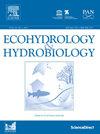Different seasonal dynamics of contrasting aquatic plants and the consequences for the submerged macrophyte biodiversity
IF 2.2
4区 环境科学与生态学
Q2 ECOLOGY
引用次数: 0
Abstract
Global warming shifts climate zones to the north, resulting in changes in biodiversity. One of the species adaptation strategies to survive is to change their phenology. In temperate climate, most aquatic plants show their peak of biomass in summer. In our study, we hypothesised that the rare charophyte Lychnothamnus barbatus and the partially invasive vascular plant Myriophyllum spicatum may apply a different seasonality and cause a decrease in the biodiversity of submerged macrophytes. The object of our study was a mesotrophic temperate lake in Western Poland with abundant submerged vegetation, where macrophyte seasonality was studied from November 2015 to November 2019 (autumn, spring, summer). Altogether, 29 taxa of plants were recorded, including 13 species of charophytes (40 % of the Polish charophyte flora) but only four species co-dominated, two eutrophic vascular plants, Ceratophyllum demersum and M. spicatum, and two charophytes, the rare mesotrophic L. barbatus and common Nitellopsis obtusa. M. spicatum due to its expansiveness in the shallow littoral decreased biodiversity in the study lake. Moreover, C. demersum negatively affected the endangered L. barbatus by direct competition for habitats in the lake. L. barbatus and M. spicatum dominated in vegetation in autumn while the further two species co-dominated in summer. L. barbartus and M. spicatum seem to avoid high competition in summer, which proves a high adaptive potential with respect to climate warming. However, further study in other lakes is needed to verify the relevance of our findings in terms of the conservation of rare macrophyte species.
对比鲜明的水生植物的不同季节动态及其对水下大型生物多样性的影响
全球变暖使气候带向北移动,导致生物多样性的变化。物种生存的适应策略之一是改变其物候。在温带气候中,大多数水生植物的生物量在夏季达到顶峰。本研究推测,罕见的绿藻Lychnothamnus barbatus和部分入侵的维管植物尖狐肉豆杉(Myriophyllum spicatum)可能具有不同的季节特征,导致水下大型植物的生物多样性下降。我们的研究对象是波兰西部一个淹没植被丰富的中营养型温带湖泊,研究了2015年11月至2019年11月(秋、春、夏)的大型植物季节性。共记录到29个植物分类群,其中船形植物13种(占波兰船形植物区系的40%),但共占优势的只有4种;富营养化维管植物Ceratophyllum demersum和M. spicatum 2种;中营养化船形植物barbatus和常见的Nitellopsis obtusa 2种;在浅海地区分布广泛的棘尾藻减少了研究湖的生物多样性。此外,该物种还通过直接竞争生境对濒临灭绝的barbatus产生负面影响。秋季以barbatus和spicatum为优势种,夏季以两种共同优势种。野蛮栗鼠和棘栗鼠在夏季似乎避开了激烈的竞争,这证明了它们对气候变暖的适应潜力很大。然而,需要在其他湖泊进一步研究,以验证我们的研究结果在珍稀大型植物物种保护方面的相关性。
本文章由计算机程序翻译,如有差异,请以英文原文为准。
求助全文
约1分钟内获得全文
求助全文
来源期刊

Ecohydrology & Hydrobiology
Agricultural and Biological Sciences-Aquatic Science
CiteScore
5.40
自引率
3.80%
发文量
51
期刊介绍:
Ecohydrology & Hydrobiology is an international journal that aims to advance ecohydrology as the study of the interplay between ecological and hydrological processes from molecular to river basin scales, and to promote its implementation as an integrative management tool to harmonize societal needs with biosphere potential.
 求助内容:
求助内容: 应助结果提醒方式:
应助结果提醒方式:


